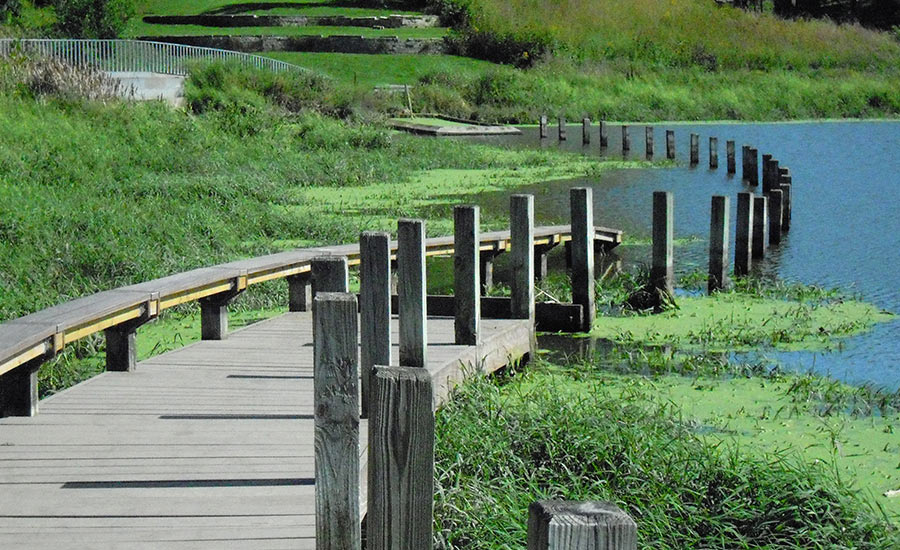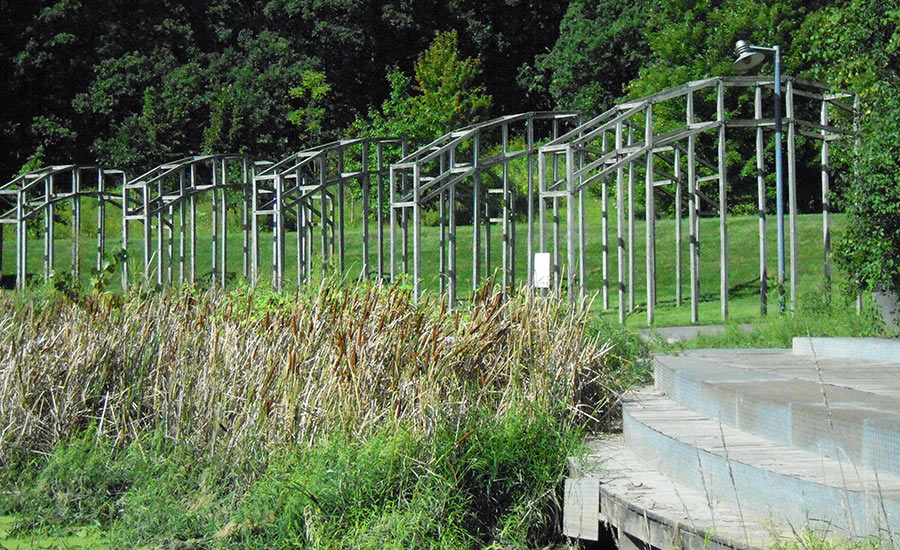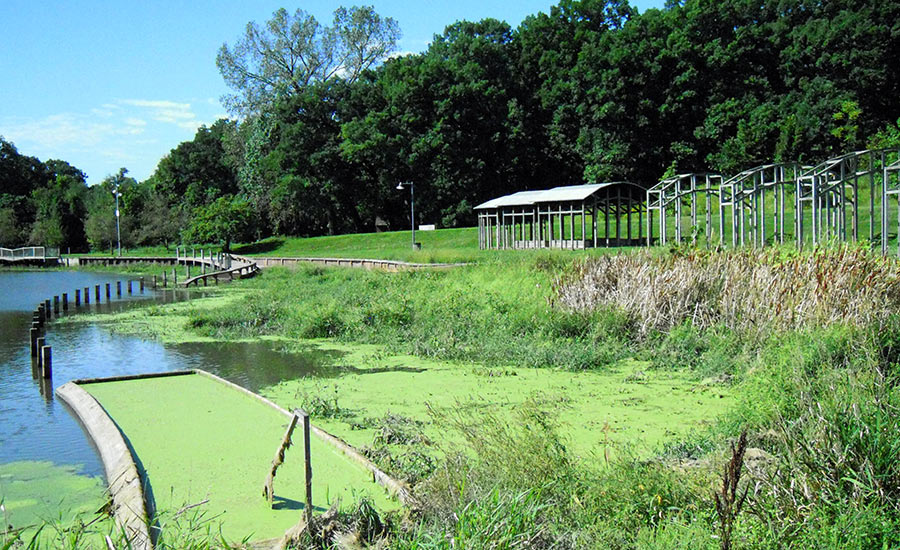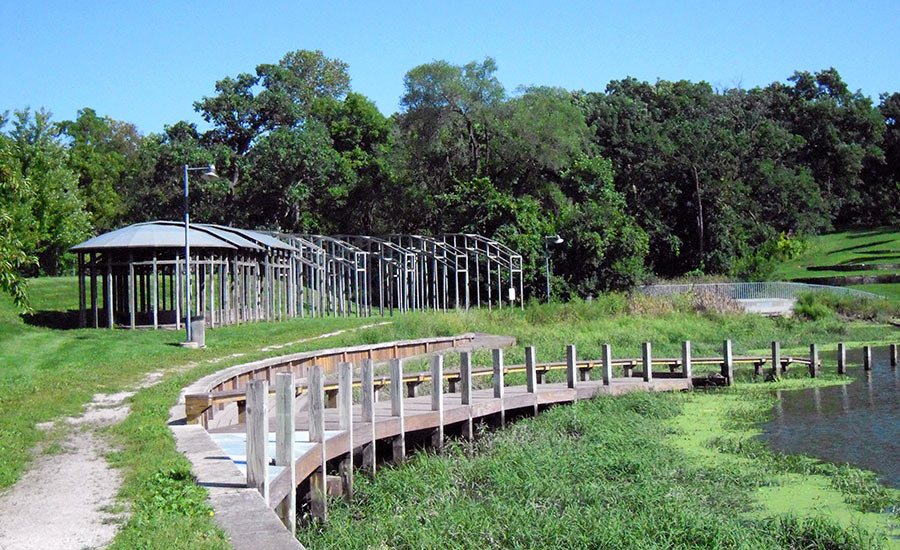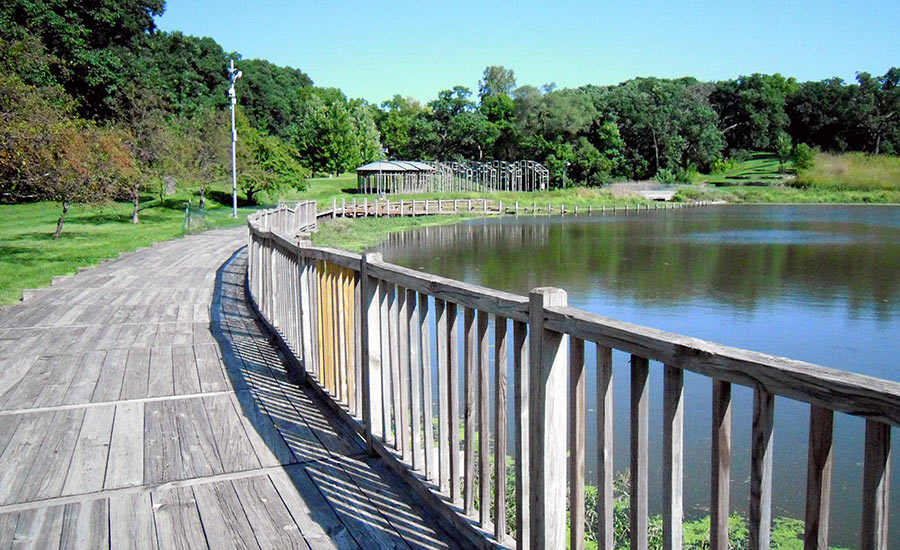“The importance of the park to the immediate neighborhood is made apparent by invoking and building upon layers of associations and memories which have collected over time. Walking around the pond, shifting between overviews and cut-outs within the water surface, the individual visitor is able to trace an intimate view of the place while putting together a new understanding of how it operates visually and physically.”
History
Mary Miss’ outdoor installation Greenwood Pond: Double Site, commissioned by the non-profit Des Moines Art Center, was created from 1989 to 1996 in consultation with local citizen groups, municipal agencies, and scientists. According to Miss, it is one of only eight permanent land works by the influential artist that remain intact, and is considered a pivotal work in her career. The museum selected Miss, Richard Serra, Bruce Nauman, and later Andy Goldsworthy, to develop works for the museum grounds in Greenwood Park, a 147-acre Picturesque park laid out by the Des Moines Parks Board in 1894, and the museum’s home since 1948. According to Jessica Rowe, director of the Greater Des Moines Public Art Foundation, “Greenwood Pond: Double Site is the first urban wetland project in the State of Iowa and also the first in the nation. It moves away from the notion of sculpture as ‘object’ and toward art understood and realized through its relationship with nature and outdoor space.”[1] However, the seminal project’s genesis was controversial.
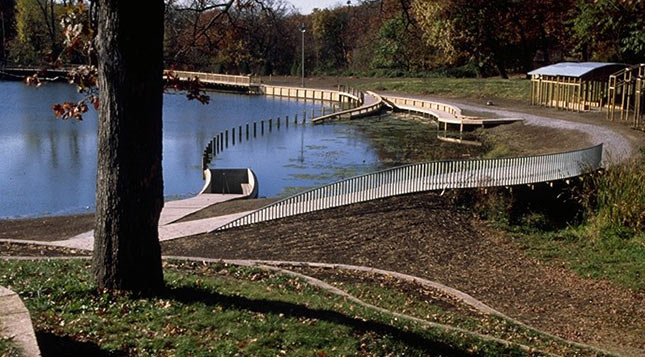
Photo by Assassi Productions, Santa Barbara, CA
Placing sculpture on the grounds of Greenwood Park was envisioned in the 1980s by Julia Brown, then director of the Art Center, as a way to bring visitors to the park and revitalize a landscape that was not being fully utilized. It was a time when environmental and site-specific art was just beginning to enter the public’s awareness – and the Museum was tasked with making its case to a skeptical public. In fact, the concept was met with strong local opposition including a lawsuit on behalf of area residents who felt that it did not recognize the desires and needs of the community. Miss saw in this discord an opportunity for collaboration. As Nancy Princenthal wrote of the artist’s approach in Art in America (April 2012), “As with any kind of activist art, the difficulty is engaging the unconvinced – or, even harder, the uninterested.”[2] Miss’s inclusive dialogue with community representatives and technical advisors – naturalists, hydrologists, educators, and planners – was essential to the design of Greenwood Pond: Double Site, and ultimately won over its opponents.
The resulting design occupies the entire perimeter of Greenwood Pond, which sits at the center of the park, south of the Des Moines Art Center campus. According to Miss: “I was taken with the idea of being able to give people in the city a sense of what it actually means to create a ‘green city’, a place where runoff water becomes a resource, not just a nuance.” The 6.5-acre urban prairie and wetland ecosystem not only engages the public with the environment, it provides wildlife habitat and stormwater mitigation.
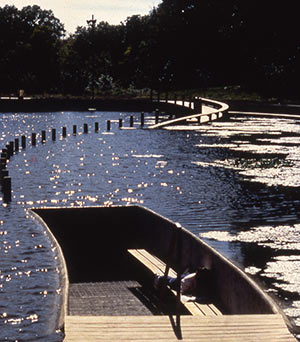
Photo by Assassi Productions, Santa Barbara, CA
A multi-level gravel and boardwalk path system curves along the edge of the pond, which is planted with wetland grasses, allowing visitors to explore the natural surroundings. To the south, a ramp diverges from the path to bring visitors down to the level of the pond before disappearing into the water. On the north side, another path also breaks away to enter the pond, where it transitions to a concrete-lined trough that allows visitors to descend until they are at eye level with the water’s surface. The two sides of the path are visually connected across the pond by a long arc marked with wood pilings. A series of structures throughout the site provide areas for gathering – these include a large covered pavilion, a seating area, an arched wooden trellis, a small bridge pavilion, and a stepped stone terrace. Interwoven throughout are visual elements, and images that reflect the history of the park site, and its surroundings.
The issues addressed in Greenwood Pond: Double Site continue to resonate in the artist’s work. A recent project, FLOW: Can You See the River? (2008-2013), commissioned by the Indianapolis Museum of Art, along the White River includes work by ten artists and was created through the collaboration of numerous arts and municipal organizations. According to an Art in America online article (September 23, 2011), “FLOW, through installations, interactive technologies, a festival and other public programming … examines how the river affects the lives of ordinary citizens, and vice versa.”[3]
Threat
Time, weather, floods, and vandalism have taken their toll on Greenwood Pond: Double Site’s wooden structures (the original materials had a life expectancy of ten to twelve years). In addition, rainwater from one quarter of the City’s land area, including what it collects along its path, drains into the pond. Creeks and basins within the park have suffered from erosion, invasive plants, and silting, which has diminished the water quality of the pond and its ability to function effectively as a conduit for drainage water. The City of Des Moines recently completed erosion control and landscape improvements on the site. In the spring of 2014 the City drained the pond to mediate the silting. The Art Center’s recent examination of the structures themselves identified seven priorities for renovation, of which four have been addressed. However, additional funding is needed to continue the renovation and properly maintain the site.
1 Neal Benezra, I. Michael Danoff, M. Jessica Rowe, et al., An Uncommon Vision: The Des Moines Art Center (Des Moines: Des Moines Art Center, 1998), 195.
2 Nancy Princenthal, “Mary Miss,” Art in America, April 2012.
3 Susan Snodgrass, “Mary Miss Goes With the Flow,” Art in America, September 23, 2011, (accessed October 1, 2014).

